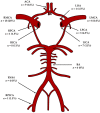Short- and Long-Term Safety and Efficacy of Self-Expandable Leo Stents Used Alone or with Coiling for Ruptured and Unruptured Intracranial Aneurysms: A Retrospective Observational Study
- PMID: 34640559
- PMCID: PMC8509248
- DOI: 10.3390/jcm10194541
Short- and Long-Term Safety and Efficacy of Self-Expandable Leo Stents Used Alone or with Coiling for Ruptured and Unruptured Intracranial Aneurysms: A Retrospective Observational Study
Abstract
To assess the efficacy and safety of the Leo stent used alone or with coiling to treat complex intracranial aneurysms (IAs) not eligible for simple or balloon-assisted coiling, this single-center retrospective study included consecutive adults with ruptured or unruptured IAs treated in 2011-2018 by stenting with or without coiling. The indication for stenting was IA complexity precluding simple or balloon-assisted coiling. Extensive data on the patients, IAs, antiplatelet treatments, procedures, and outcomes over the first 36 months were collected. Risk factors for early complications (univariate analysis) and delayed ischemia (multivariate analysis) were sought. We include 64 patients with 66 IAs. The procedural success rate was 65/66 (98.5%). Obliteration was Raymond Roy class I or II for 85% of IAs. Six patients died including four of the 12 patients presenting with subarachnoid hemorrhage, which was the only significant risk factor for early major complications. At 1 month, 45/64 (69%) had no disabilities. No rebleeding was reported. Ischemia was detected by routine MRI in 20 (35%) of the 57 patients with long-term data and was asymptomatic in 14. The stent-within-a-stent configuration was the only independent risk factor for ischemia. The Leo stent used alone or with coils to manage challenging IAs was associated with a high procedural success rate and complete or nearly complete IA obliteration of 85% of IAs. The high frequency of ischemia is ascribable to our use of routine serial MRI. In patients with bleeding, the Leo stent was associated with an excess risk of early, major, intracranial complications, as compared to patients without bleeding. Long-term follow-up was marked by the occurrence of ischemic events in the vascular territory of the stent, mostly silent.
Keywords: coiling; endovascular treatment; intracranial aneurysm; remodeling technique; self-expandable stent; subarachnoid hemorrhage.
Conflict of interest statement
The authors declare no conflict of interest.
Figures


References
-
- Debette S., Compter A., Labeyrie M.A., Uyttenboogaart M., Metso T.M., Majersik J.J., Goeggel-Simonetti B., Engelter S.T., Pezzini A., Bijlenga P., et al. Epidemiology, pathophysiology, diagnosis, and management of intracranial artery dissection. Lancet Neurol. 2015;14:640–654. doi: 10.1016/S1474-4422(15)00009-5. - DOI - PubMed
LinkOut - more resources
Full Text Sources

